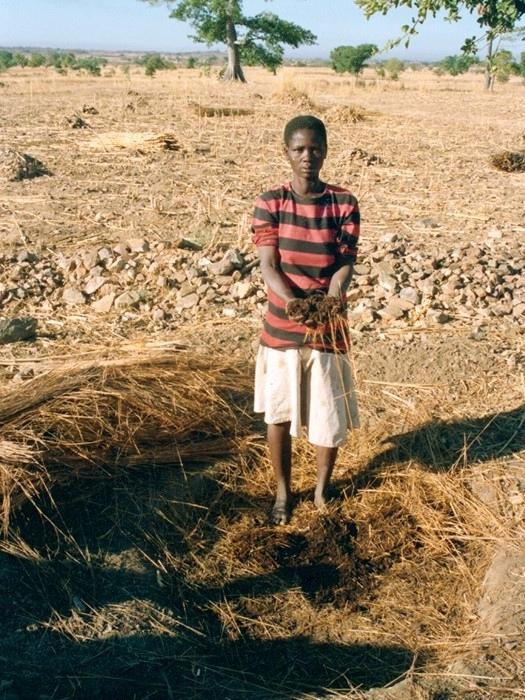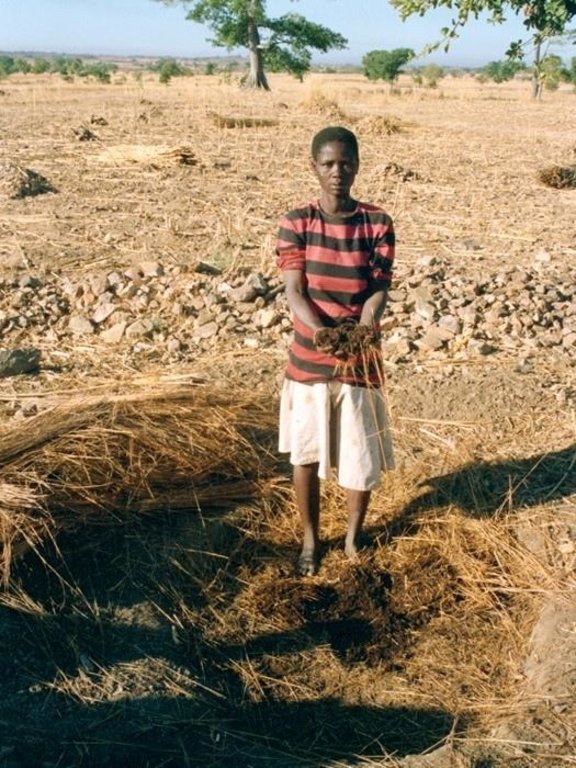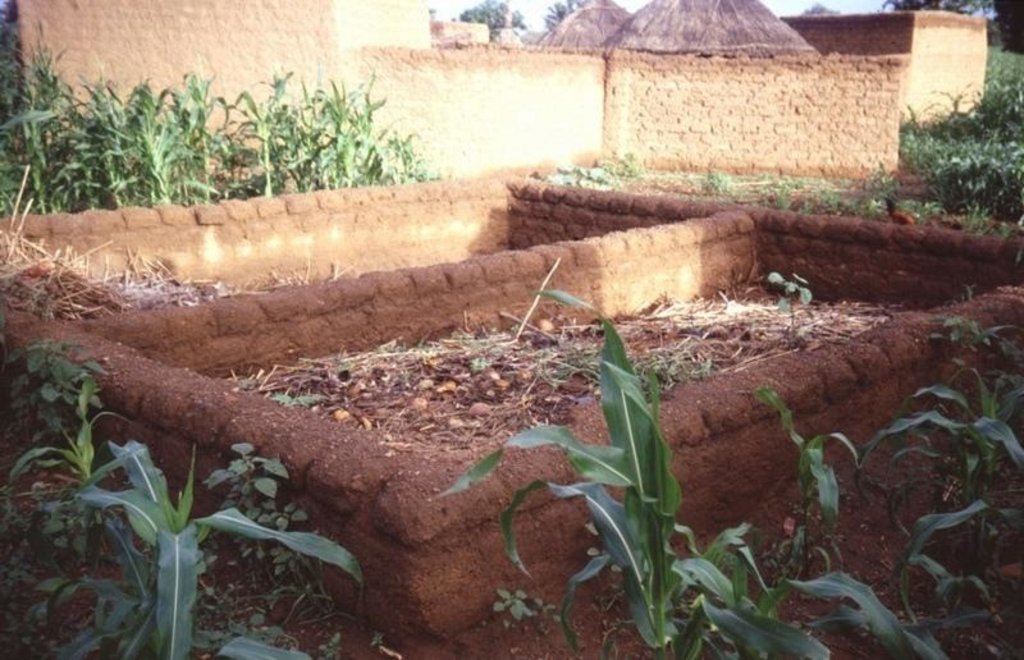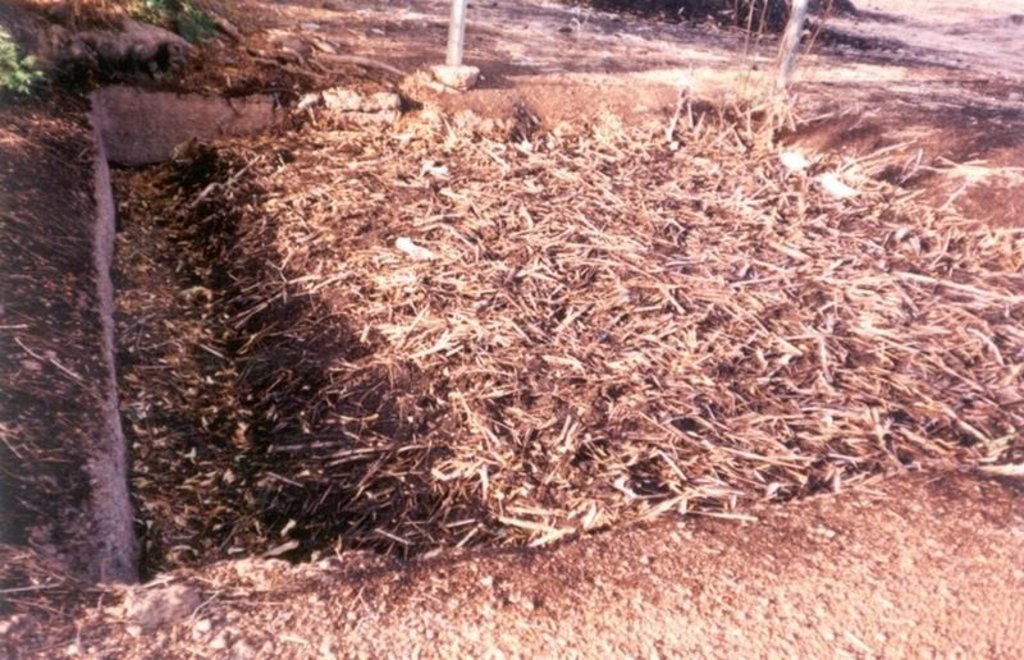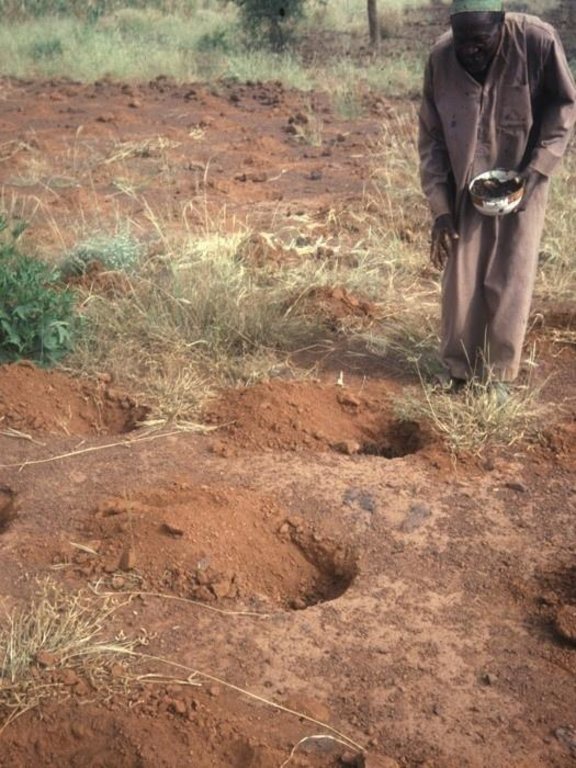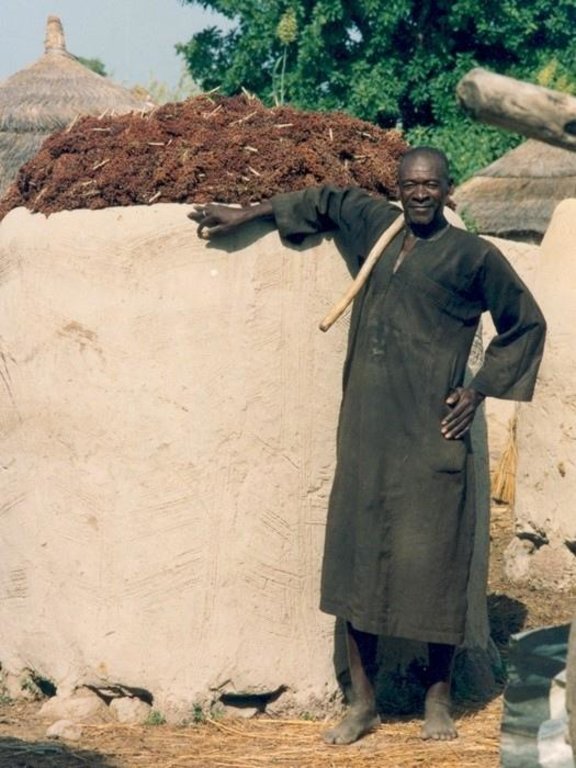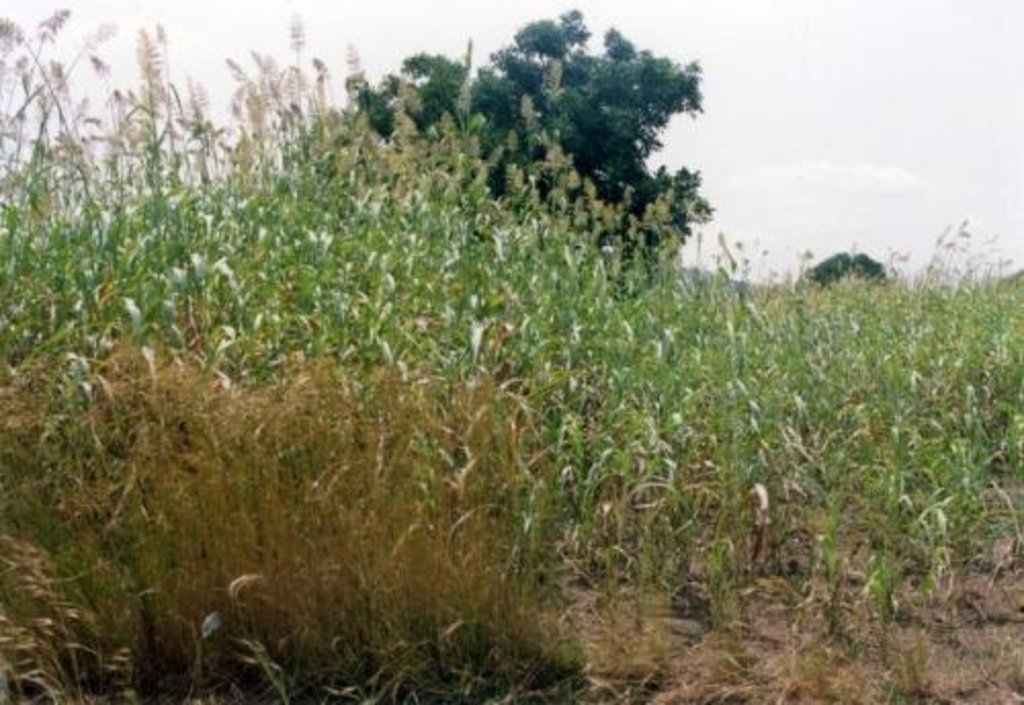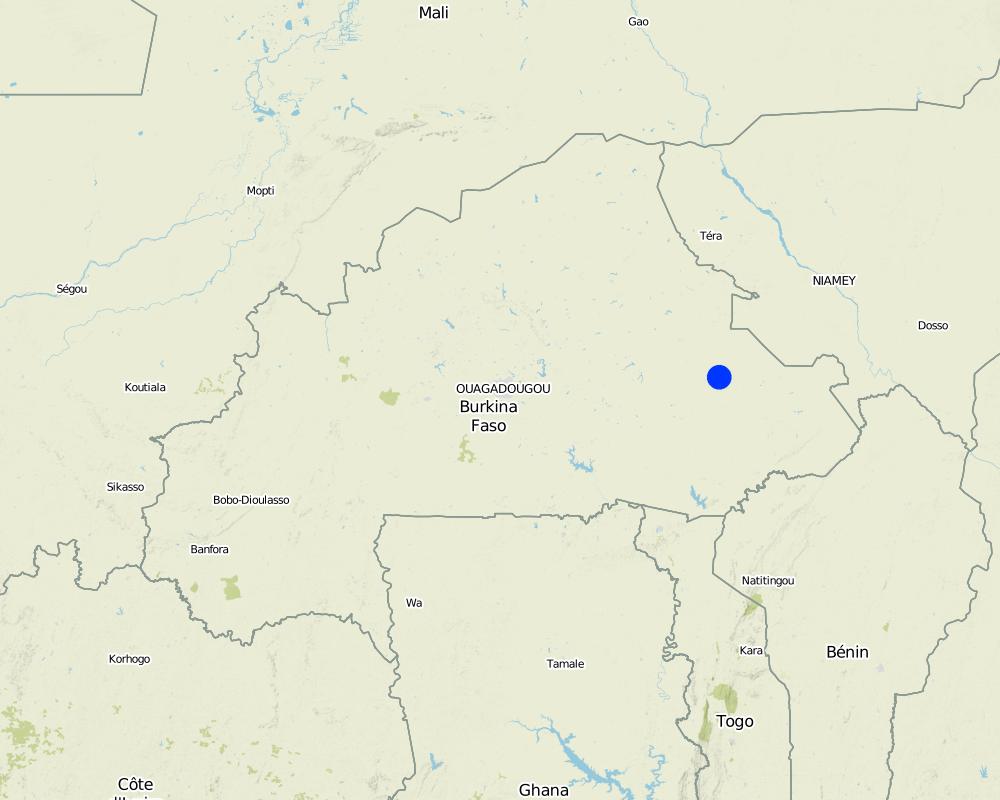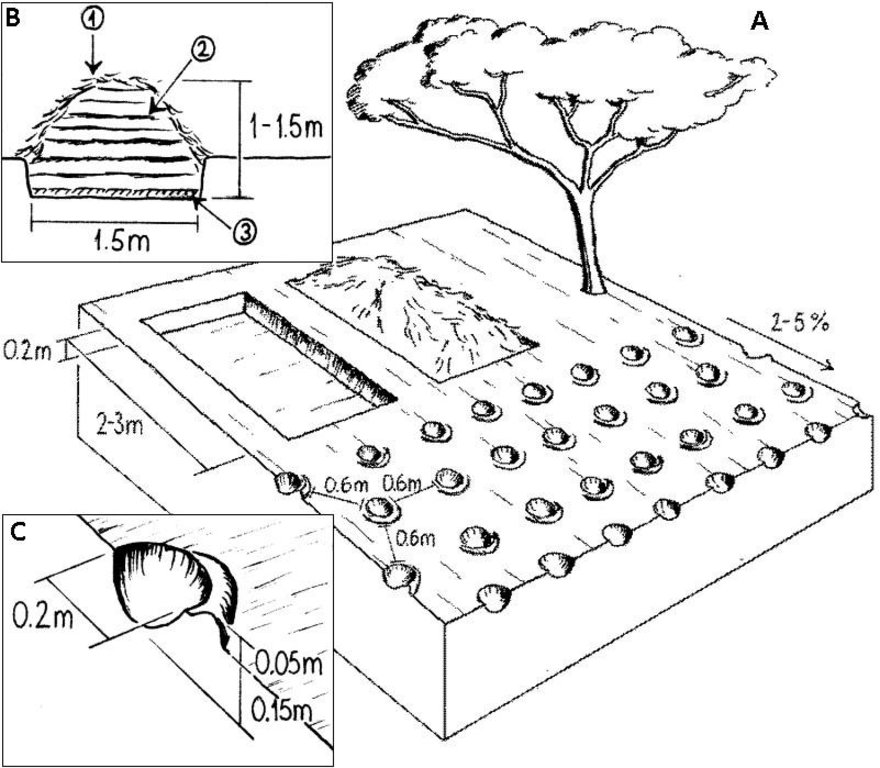Composting associated with planting pits [Буркина Фасо]
- Шинийг нээх:
- Шинэчлэх:
- Мэдээлэл цуглуулсан: Moussa Bonzi
- Редактор: –
- Хянагч: Fabian Ottiger
Zai avec apport de compost (french)
technologies_959 - Буркина Фасо
Бүлгүүдийг үзэх
Бүгдийг харуулах Бүгдийг хаах1. Ерөнхий мэдээлэл
1.2 Технологийг үнэлэх, баримтжуулах ажилд хамаарах мэдээлэл өгсөн хүмүүс, байгууллагуудын холбоо барих мэдээлэл
Мэдээлэл өгсөн хүн (с)
ГТМ мэргэжилтэн :
De Pury Jean Pascal Etienne
Centre Ecologique Albert Schweitzer (CEAS)
Rue des Amandiers 2, 2000 Neuchâtel
Швейцар
ГТМ мэргэжилтэн :
Ouedraogo Elisée
oelisee@hotmail.com
Centre Ecologique Albert Schweitzer (CEAS)
Rue des Amandiers 2, 2000 Neuchâtel
Швейцар
ГТМ мэргэжилтэн :
Технологи баримтжуулах/үнэлэх ажилд дэмжлэг үзүүлсэн төслийн нэр (шаардлагатай бол)
Book project: where the land is greener - Case Studies and Analysis of Soil and Water Conservation Initiatives Worldwide (where the land is greener)Технологи баримтжуулах/үнэлэх ажилд дэмжлэг үзүүлсэн төслийн нэр (шаардлагатай бол)
Book project: SLM in Practice - Guidelines and Best Practices for Sub-Saharan Africa (SLM in Practice)Технологи баримтжуулах/үнэлэх ажилд дэмжлэг үзүүлсэн байгууллага(ууд)-ын нэр (шаардлагатай бол)
Centre Ecologique Albert Schweitzer (CEAS) - ШвейцарТехнологи баримтжуулах/үнэлэх ажилд дэмжлэг үзүүлсэн байгууллага(ууд)-ын нэр (шаардлагатай бол)
INERA Institut de l'environnement et de recherches agricoles (INERA Institut de l'environnement et de recherches agricoles) - Буркина Фасо1.3 WOCAT-аар баримтжуулсан өгөгдлийг ашиглахтай холбоотой нөхцөл
Мэдээллийг хэзээ (газар дээр нь) цуглуулсан бэ?
01/08/2002
Эмхэтгэгч болон гол мэдээлэгч хүн(хүмүүс) WOCAT аргачлалаар баримтжуулсан мэдээллийг ашиглахтай холбоотой нөхцлийг хүлээн зөвшөөрсөн.
Тийм
1.5 ГТМ-ийн Арга барилын талаархи санал асуулгын(д) суурь мэдээлэл
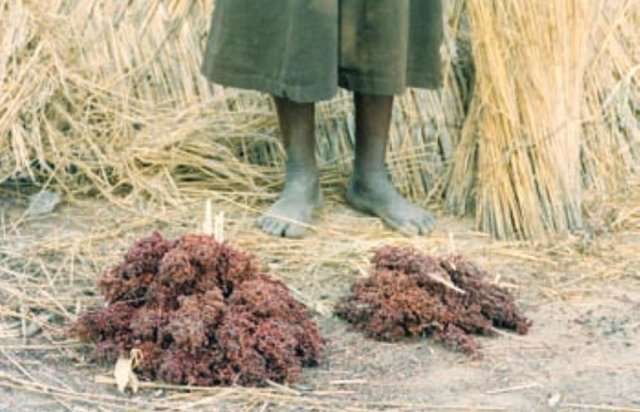
Zabré women’s agroecological programme [Буркина Фасо]
A demand-driven initiative, by a women’s association, aimed at the promotion of composting through training and extension, using project staff and local facilitators.
- Мэдээлэл цуглуулсан: Unknown User
2. ГТМ Технологийн тодорхойлолт
2.1 Технологийн товч тодорхойлолт
Технологийн тодорхойлолт:
Compost production, and its application in planting pits (zai) by farmers on fields near their homes.
2.2 Технологийн дэлгэрэнгүй тайлбар
Тодорхойлолт:
Compost is produced in shallow pits, approximately 20 cm deep and 1.5 m by 3 m wide. During November and December layers of chopped crop residues, animal dung and ash are heaped, as they become available, up to 1.5 m high and watered. The pile is covered with straw and left to heat up and decompose. After around 15-20 days the compost is turned over into a second pile and watered again. This is repeated up to three times - as long as water is available. Compost heaps are usually located close to the homestead. Alternatively, compost can be produced in pits which are up to one metre deep. Organic material is filled to ground level. The pit captures rain water, which makes this method of composting
a valuable option in dry areas.
The compost is either applied immediately to irrigated gardens, or kept in a dry shaded place for the next sorghum seeding. In the latter case one handful of compost is mixed with loose soil in each planting pit (zai). These pits are dug 60 cm by 60 cm apart. Three to four grains of sorghum are planted in each pit. Compost in the pits both conserves water and supplies nutrients. This enables the sorghum plants to establish better, grow faster and reach maturity before the rains finish. As compost is applied locally to the crop, not only is the positive effect maximised, but also the weeds between the pits do not benefit. The water retaining capacity of the compost (absorbing several times its own weight) makes the difference. This is much more important than the additional nutrients, which only become available in subsequent years, and do not anyway completely replace all the nutrients extracted by the crops.
The planting pits also help by harvesting runoff water from the microcatchments between them. Boulgou experiences erratic and variable rainfall with frequent droughts. The poor soils are often crusted and have a low water-retention capacity. Due to a high and increasing population, the land has become exhausted, and fallow periods are no longer sufficient as a consequence. Fertility and yields have declined. Sorghum without compost is more vulnerable to drought and crop failure.
During the dry season, after harvest, fields are grazed by cattle of the nomadic pastoral Peuhl, who also herd the agriculturalists’ livestock. Interestingly, the Peuhl have started to systematically collect the manure for sale, since the increased demand (for composting) has led to doubling of the price. Composting has been applied in Boulgou Province of Burkina Faso since 1988.
2.3 Технологийн гэрэл зураг
2.5 Энэ үнэлгээнд хамрагдсан технологийг хэрэгжүүлсэн улс орон / бүс нутаг / байршил
Улс :
Буркина Фасо
Улс/аймаг/сум:
Boulgou Province, Burkina Faso
Map
×2.7 Технологийн танилцуулга
Технологийг хэрхэн нэвтрүүлснийг тодорхойл:
- Гадны төсөл/хөтөлбөрийн дэмжлэгтэйгээр
3. ГТМ технологийн ангилал
3.1 Технологийн үндсэн зорилго (д)
- Үйлдвэрлэлийг сайжруулах
- Үр ашигтай эдийн засгийн нөлөөг бий болгох
3.2 Технологи хэвтрүүлсэн газрын одоогийн газар ашиглалтын хэлбэр(д)

Холимог (тариалан/бэлчээр/мод), үүнд. ХАА-н ойжуулалт
- Агро-пасторализм
Гол бүтээгдэхүүн ба үйлчилгээ:
Sorghum and zebu cattle (after harvest)
Тайлбар:
Major land use problems (compiler’s opinion): Population increase has led to cultivation of all the available arable land, thus shortening or eliminating fallow periods.
Organic matter in the soil is reduced, the water holding capacity of the soil has diminished and consequently yields have fallen. This has been compounded by the droughts of the 1970s and 1980s. Thirty years ago farmers harvested 800 kg/ha each year, but by the 1980s yields had fallen to merely 400 kg/ha on average.
3.3 Газар ашиглалтын нэмэлт мэдээлэл
Технологи хэрэгжүүлсэн газрын усан хангамж:
- Байгалийн усалгаатай
Тодорхойлно уу:
Longest growing period in days: 180 Longest growing period from month to month: May - Oct
3.4 Технологи ГТМ-ийн аль бүлэгт хамаарах
- гадаргын/ ургамал бүрхэвч сайжрах
- Хөрсний үржил шимт цогц менежмент
- Ус хураах
3.5 Технологийн тархалт
Тайлбар:
Total area covered by the SLM Technology is 200 m2.
3.6 Технологийг бүрдүүлэх ГТМ арга хэмжээ

Агрономийн арга хэмжээ
3.7 Технологийн шийдвэрлэсэн газрын доройтлын үндсэн төрлүүд

Хөрс усаар эвдрэх
- Wt: Хөрсний гадаргын угаагдал

Хөрсний химийн доройтол
- Cn: Үржил шим болон органик агууламж буурах (элэгдлийн шалтгаангүй)

Хөрсний физик доройтол
- Pc: Хөрс дагтарших
- Pk: Гадаргуу дээр өгөршлийн давхарга үүсэх

Усны доройтол
- Ha: Хуурайшилт
Тайлбар:
Main type of degradation addressed: Wt: loss of topsoil / surface erosion, Cn: fertility decline and reduced organic matter content, Pc: compaction, Pk: sealing and crusting, Ha: aridification
Main causes of degradation: over-exploitation of vegetation for domestic use, other human induced causes (specify) (causes agricoles: Suppression des jachères; surpâturage), other natural causes (avalanches, volcanic eruptions, mud flows, highly susceptible natural resources, extreme topography, etc.) specify (Secheresse du sol due à la destruction de l'humus plus qu'aumanque de pluie.), Expansion démographique, manque de connaissances (Comment acquerir ces connaissances)
Secondary causes of degradation: deforestation / removal of natural vegetation (incl. forest fires), manque de moyens financiers (comment en produire avec des connaissances)
3.8 Газрын доройтлоос урьдчилан сэргийлэх, сааруулах ба нөхөн сэргээх
Газрын доройтолтой холбоотойгоор Технологи ямар зорилго тавьсан болохыг тодорхойл:
- Газрын доройтлыг багасгах сааруулах
4. Техникийн нөхцөл, хэрэгжилтийн үйл ажиллагаа, материал ба зардал
4.1 Технологийн техникийн зураг
4.2 Техникийн үзүүлэлтүүд/ техникийн зургийн тайлбар
A: Overview of compost making and zai planting pits within a field. Tree shade helps to conserve moisture in the compost pits.
B: Cross section of compost pit: protective straw (1); successive layers of compost (2), clay layer at the bottom (3).
C: Detailed view of zai planting pit.
Technical knowledge required for field staff / advisors: low
Technical knowledge required for land users: moderate
Main technical functions: increase / maintain water stored in soil
Secondary technical functions: increase in organic matter, increase of infiltration, increase in soil fertility, improvement of soil structure
Manure / compost / residues
Material/ species: compost
Quantity/ density: 7-10 t/ha
Remarks: applied in planting pits
4.4 Байгуулах үйл ажиллагаа
| Үйл ажиллагаа | Арга хэмжээний төрөл | Хугацаа | |
|---|---|---|---|
| 1. | Transport compost to the fields: | April / annual | |
| 2. | Deepen planting pits (zai) (to original dimensions of 15 cm deep, 20 cm diameter, and 60 cm apart) and apply a handful of compost mixed with earth, just before planting sorghum | After the first rains / annual |
Тайлбар:
Editors’ comments: Soil fertility decline is a major problem for much of Africa, and composting provides an opportunity for local mitigation of this. There are many ways of making compost, and this case is a good example of ‘aerobic heap compost’ from Burkina Faso. Here, the compost is concentrated in planting pits, which additionally harvest water.
4.5 Байгуулалтад шаардагдах зардал ба материал
| Хөрөнгө оруулалтыг дурьдана уу | Хэмжих нэгж | Тоо хэмжээ | Нэгжийн өртөг | Материал бүрийн нийт өртөг | % газар ашиглачаас гарсан зардал | |
|---|---|---|---|---|---|---|
| Хөдөлмөр эрхлэлт | Labour | ha | 1.0 | 2.0 | 2.0 | 100.0 |
| Тоног төхөөрөмж | Tools | ha | 1.0 | 10.0 | 10.0 | 100.0 |
| Барилгын материал | Clay | 1 | ||||
| Технологи бий болгох нийт үнэ өртөг | 12.0 | |||||
4.6 Засвар үйлчилгээ / давтагдах үйл ажиллагаа
| Үйл ажиллагаа | Арга хэмжээний төрөл | Хугацаа/ давтамж | |
|---|---|---|---|
| 1. | Dig two compost pits (3 m by 1.5 m and 20 cm deep). Cover the bottom of each pit with 3 cm clay layer. | Агрономийн | beginning of the dry season (November). / initial establishment |
| 2. | Put 20 cm layer of chopped crop residues (cereal straw) into thecompost pit (water with one bucket). Add 5 cm layer of animal manure. Add 1 cm layer of ash. Repeat steps 1–3 until the compost pile is 1.0–1.5 m high. | Агрономийн | November / annual |
| 3. | Cover pile with straw to reduce evaporation, and leave to decompose. | Агрономийн | November / annual / up to 3 times (as long as water is available) |
| 4. | Turn compost after 15 days into the 2nd pit, then after another 15 days back into the 1st pit. Water the pile after each turning with 3 buckets of water. | Агрономийн | / up to 3 times (as long as water is available) |
| 5. | Store ready compost in dry shady place. | Агрономийн | January / annual |
4.7 Засвар үйлчилгээ / урсгал үйл ажиллагаанд шаардагдах зардал ба материал (жилээр)
| Хөрөнгө оруулалтыг дурьдана уу | Хэмжих нэгж | Тоо хэмжээ | Нэгжийн өртөг | Материал бүрийн нийт өртөг | % газар ашиглачаас гарсан зардал | |
|---|---|---|---|---|---|---|
| Хөдөлмөр эрхлэлт | Labour | ha | 1.0 | 20.0 | 20.0 | 100.0 |
| Тоног төхөөрөмж | Wheelbarrow renting | ha | 1.0 | 6.0 | 6.0 | 100.0 |
| Тоног төхөөрөмж | None | None | 1.0 | |||
| Тоног төхөөрөмж | None | None | 1.0 | |||
| Бордоо ба биоцид | Compost/manure | ha | 1.0 | 2.0 | 2.0 | 100.0 |
| Барилгын материал | Wet straw | ha | ||||
| Барилгын материал | ash | ha | ||||
| Бусад | Compost transportation | ha | 1.0 | 2.0 | 2.0 | 100.0 |
| Технологийг арчилах тордоход шаардагдах нийт үнэ өртөг | 30.0 | |||||
Тайлбар:
Machinery/ tools: hoe, knife, digging stick, bucket
Costs relate to production and application of one ton of compost per hectare - which a farmer can make in one year and is the product of one full compost pit. The compost is directly applied to each planting pit: since the pits all in all
constitute only around 10-15% of the field surface, compost is effectively applied at a concentration of 7-10 t/ha. This rate is equal to actual rates applied in small irrigated gardens (<0.1 ha). If compost is produced in deep pits, production is cheaper because there is less work involved.
4.8 Зардалд нөлөөлж байгаа хамгийн чухал хүчин зүйл
Өртөг зардлыг тодорхойлох гол хүчин зүйлсийг дурьдана уу:
Duration of establishment: 1 week
5. Хүн, байгалийн хүрээлэн буй орчин
5.1 Уур амьсгал
Жилийн нийлбэр хур тундас
- <250 мм
- 251-500 мм
- 501-750 мм
- 751-1,000 мм
- 1,001-1,500 мм
- 1,501-2,000 мм
- 2,001-3,000 мм
- 3,001-4,000 мм
- > 4,000 мм
Агро-уур амьсгалын бүс
- Хагас хуурай
Thermal climate class: tropics
5.2 Байрзүйн зураг
Дундаж налуу:
- Тэгш (0-2 %)
- Бага зэрэг хэвгий (3-5 %)
- Дунд зэрэг хэвгий (6-10 % )
- Долгиорхог (11-15 %)
- Толгодорхог (16-30 %)
- Эгц налуу (31-60 % )
- Огцом эгц налуу (>60 %)
Гадаргын хэлбэр:
- Тэгш өндөрлөг/тэгш тал
- Зоо, хяр
- Уулын энгэр, хажуу
- Ухаа, гүвээ, дов толгод
- Уулын бэл
- Хөндий, хоолой, нам хотос
Өндөршлийн бүс:
- 0-100 м д.т.д
- 101-500 м д.т.д
- 501-1,000 м д.т.д
- 1,001-1,500 м д.т.д
- 1,501-2,000 м д.т.д
- 2,001-2,500 м д.т.д
- 2,501-3,000 м д.т.д
- 3,001-4,000 м д.т.д
- > 4,000 м д.т.д
5.3 Хөрс
Хөрсний дундаж зузаан:
- Маш нимгэн (0-20 см)
- Нимгэн (21-50 см)
- Дунд зэрэг зузаан (51-80 см)
- Зузаан (81-120 cм)
- Маш зузаан (>120 cм)
Хөрсний бүтэц (өнгөн хөрс):
- Сийрэг/хөнгөн (элсэрхэг)
- Хүнд (шаварлаг)
Өнгөн хөрсний органик нэгдэл:
- Бага (<1 % )
Боломжтой бол хөрсний бүрэн тодорхойлолт, боломжит мэдээллийг өгнө үү, жишээ нь хөрсний төрөл, хөрсний урвалын орчин/хүчиллэг байдал, катион солилцох чадавхи, азотын хэмжээ, давсжилт г.м.
Soil texture: Fine / heavy (elevations) and coarse/light (depressions)
Soil fertility: Low (ranked 1) and medium (ranked 2)
Topsoil organic matter: Low (and decreasing further)
Soil drainage/infiltration: Poor (ranked 1) and medium (ranked 2)
Soil water storage capacity: Low
5.6 Технологи нэвтрүүлсэн газар ашиглагчидын онцлог шинж
Үйлдвэрлэлийн системийн зах зээлийн чиг баримжаа:
- Амь зуух арга хэлбэрийн (өөрийгөө хангах)
- Холимог (амь зуух/ худалдаа наймаа
Фермээс гадуурх орлого:
- Нийт орлогын %10 доош хувь
Механикжилтын түвшин:
- Хүнд хүчир ажил
- Амьтны зүтгүүр
Газар ашиглагчдын бусад шаардлагатай шинж чанарыг тодорхойл:
Market orientation: Subsistence (ranked 1) and mixed (ranked 2, in good years)
5.7 Технологи нэвтрүүлсэн газар ашиглагчдын эзэмшдэг эсвэл түрээслэдэг газрын дундаж талбай
- < 0.5 га
- 0.5-1 га
- 1-2 га
- 2-5 га
- 5-15 га
- 15-50 га
- 50-100 га
- 100-500 га
- 500-1,000 га
- 1,000-10,000 га
- > 10,000 га
Тайлбар:
Average area of land owned or leased by land users applying the Technology: 0.5-1 ha, 1-2 ha, 2-5 ha
5.8 Газар эзэмшил, газар ашиглах эрх, ус ашиглах эрх
Газар өмчлөл:
- Нэгдэл/ тосгон
Газар ашиглах эрх:
- Нэгдлийн хэлбэрээр (зохион байгуулалттай)
6. Үр нөлөө ба дүгнэлт
6.1 Технологийн талбай дахь үр нөлөө
Нийгэм-эдийн засгийн үр нөлөө
Үйлдвэрлэл
Газар тариалангийн үйлдвэрлэл
тэжээл үйлдвэрлэл
тэжээлийн чанар
Орлого, зарлага
тариалангийн газрын орлого
Тайлбар/ тодорхой дурьдах:
By several times in dry years, compared to no compost use
хөдөлмөр хүчний хэмжээ
Бусад нийгэм-эдийн засгийн нөлөөллүүд
Integration of agriculturalists and pastoralists
Input constraints
Тайлбар/ тодорхой дурьдах:
Water for compost making
Нийгэм-соёлын үр нөлөө
олон нийтийн институц
маргааныг шийдвэрлэх
Экологийн үр нөлөө
Усны эргэлт/ илүүдэл
илүүдэл ус урсгах
Хөрс
хөрсний чийг
хөрсөн бүрхэвч
хөрс алдагдах
Бусад экологийн үр нөлөө
Soil fertility
6.4 Зардал ба үр ашгийн шинжилгээ
Үр ашгийг барилга байгууламжийн зардалтай (газар ашиглагчдын үзэл бодлоор) хэрхэн харьцуулах вэ?
Богино хугацаанд эргэн төлөгдөх байдал:
Маш эерэг
Урт хугацаанд эргэн төлөгдөх байдал:
Маш эерэг
Үр ашгийг засвар үйлчилгээ/ урсгал зардалтай (газар ашиглагчдын үзэл бодлоор) хэрхэн харьцуулах вэ?
Богино хугацаанд эргэн төлөгдөх байдал:
Маш эерэг
Урт хугацаанд эргэн төлөгдөх байдал:
Маш эерэг
6.5 Технологи нутагшуулах
Боломжтой бол, тоогоор илэрхийл (өрхийн тоо эсвэл бүрхэх талбай):
5000
Технологийн нэвтрүүлсэн иргэдээс хэд нь өөрийн санаачлагаар буюу өөр эх үүсвэрээс материалын болон мөнгөн дэмжлэг авалгүй нэвтрүүлсэн бэ?
- 90-100 %
Тайлбар:
100% of land user families have adopted the Technology without any external material support
There is a strong trend towards spontaneous adoption of the Technology
Comments on adoption trend: Strong trend towards growing spontaneous adoption. Almost everybody wants to imitate neighbors - but not everyone had received adequate training. Demand grew because of the expanded membership of the association. Some pastoralists use it in their gardens.
6.7 Технологийн давуу тал/боломжууд
| Эмхэтгэгч, бусад мэдээлэл өгсөн хүмүүсийн өнцгөөс тодорхойлсон давуу тал/боломжууд |
|---|
|
All land users, even the poorest, can learn to make and apply compost. No jealousy amongst land users, which is a prerequisite for ist spread/acceptance How can they be sustained / enhanced? Keep going with training and extension. |
|
Possibility of doubling cereal yields in normal years: any surplus production can be sold How can they be sustained / enhanced? Produce enough good compost/manure. |
| Ensures yields in dry years, giving security against drought and hunger. |
|
Gives high income in dry years due to production increase and double prices on the market for the surplus How can they be sustained / enhanced? However the government is attempting to stabilise prices, so this benefit might not endure. |
| Requires only locally available resources, and knowledge about compost application is ‘owned’ by the farmers: nobody can take it away from them. |
6.8 Технологийн дутагдалтай/сул тал/аюул болон тэдгээрийн хэрхэн даван туулах арга замууд
| Эмхэтгэгч, бусад мэдээлэл өгсөн хүмүүсийн өнцгөөс тодорхойлсон сул тал/ дутагдал/ эрсдэл | Тэдгээрийг хэрхэн даван туулах вэ? |
|---|---|
| The modest quantity of compost applied is not enough to replace the nutrients extracted by the crops in the long term | Small amounts of nitrogen and phosphorous fertiliser need to be added and crop rotation practiced. |
| The short/medium term local benefits are not associated with a positive overall, long-term ecological impact because there is a net transfer of organic matter (manure) to the fields from the surroundings | Improve management of the vegetation outside the cropland, avoiding overgrazing etc to increase manure production. |
| Needs considerable water and thus also extra labour | Pit composting helps to reduce water requirement in drier areas and at the same time reduces labour input. |
7. Ном зүй ба холбоосууд
7.2 Хүртээмжтэй ном, бүтээлийн ишлэл
Гарчиг, зохиогч, он, ISBN:
Ouedraogo E . Influence d’un amendement de compost sur sol ferrugineux tropicaux en milieu paysan. Impact sur la
production de sorgho à Zabré en 1992. Mémoire de diplôme.. 1992.
Хаанаас авч болох вэ? Зардал?
CEAS Neuchâtel, Switzerland
Гарчиг, зохиогч, он, ISBN:
Zougmore R, Bonzi M, et Zida Z . Etalonnage
des unités locales de mesures pour le compostage en fosse de type unique étanche durable. Fiche technique de quantification des matériaux de
compostage, 4pp. 2000.
Гарчиг, зохиогч, он, ISBN:
Zougmore R, Bonzi M, et Zida Z . Etalonnage
des unités locales de mesures pour le compostage en fosse de type unique étanche durable. Fiche technique de quantification des matériaux de
compostage, 4pp. 2000.
Гарчиг, зохиогч, он, ISBN:
Zougmore R, Bonzi M, et Zida Z . Etalonnage
des unités locales de mesures pour le compostage en fosse de type unique étanche durable. Fiche technique de quantification des matériaux de
compostage, 4pp. 2000.
Гарчиг, зохиогч, он, ISBN:
Zougmore R, Bonzi M, et Zida Z . Etalonnage
des unités locales de mesures pour le compostage en fosse de type unique étanche durable. Fiche technique de quantification des matériaux de
compostage, 4pp. 2000.
Гарчиг, зохиогч, он, ISBN:
Zougmore R, Bonzi M, et Zida Z . Etalonnage
des unités locales de mesures pour le compostage en fosse de type unique étanche durable. Fiche technique de quantification des matériaux de
compostage, 4pp. 2000.
Холбоос ба модулууд
Бүгдийг харуулах Бүгдийг хаахХолбоосууд

Zabré women’s agroecological programme [Буркина Фасо]
A demand-driven initiative, by a women’s association, aimed at the promotion of composting through training and extension, using project staff and local facilitators.
- Мэдээлэл цуглуулсан: Unknown User
Модулууд
Модуль байхгүй байна


